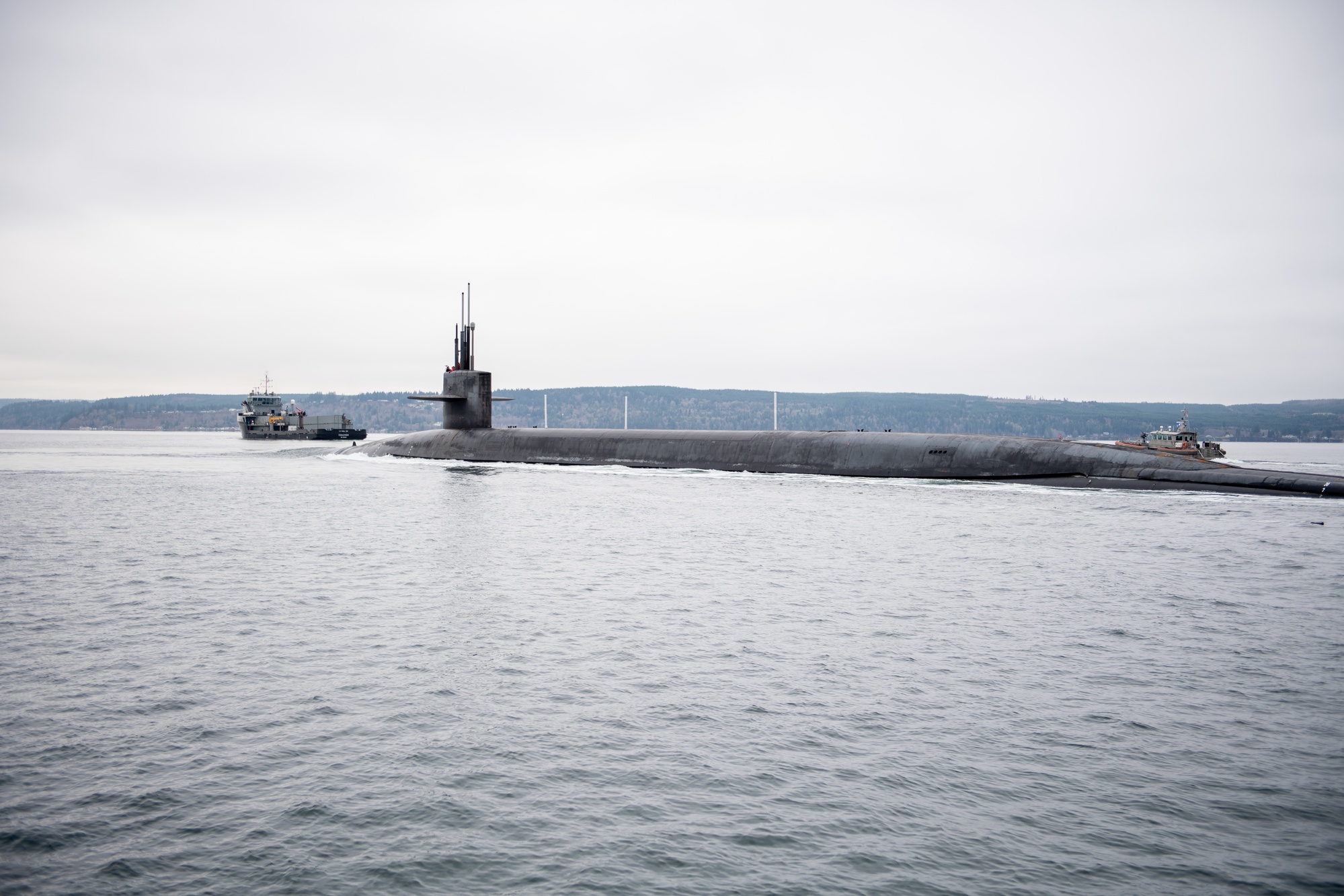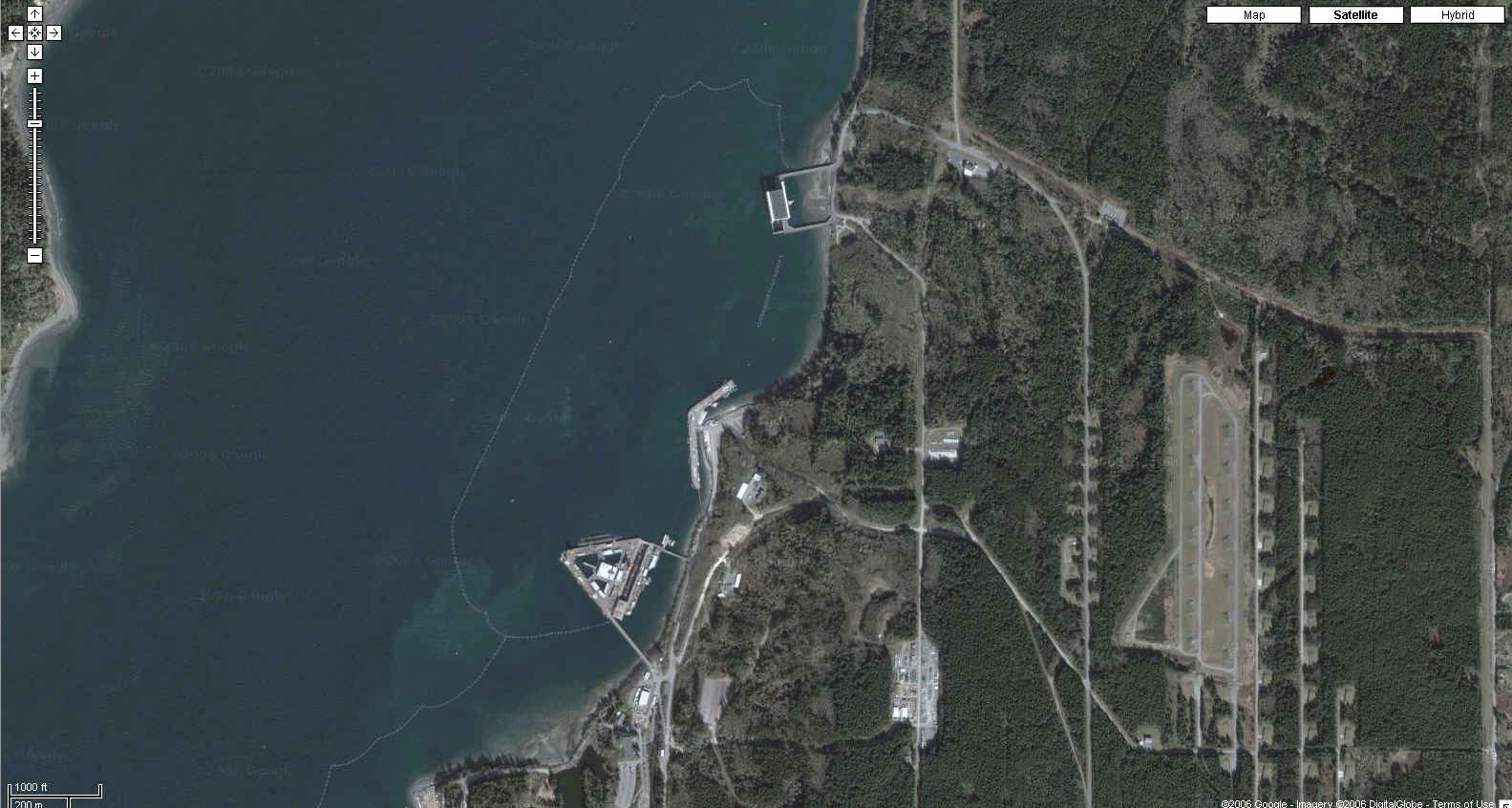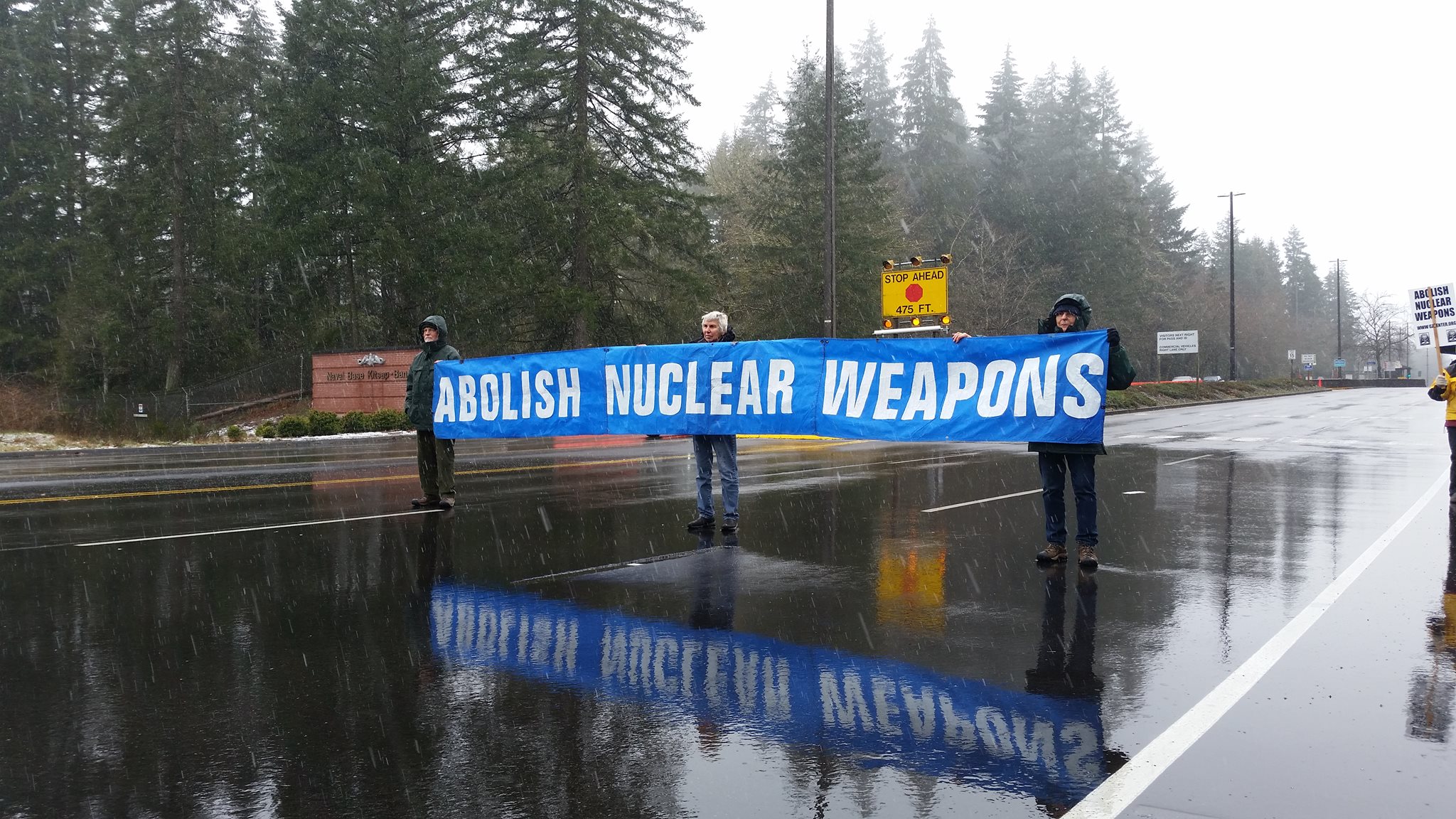Bangor Washington Sub Base - 47°43′27.84″N 122°43′12.17″W / 47.7244000°N 122.7200472°W / 47.7244000; -122.7200472 Approx: 47°43′27.84″N 122°43′12.17″W / 47.7244000°N 122.7200472°W / 47.7244000; -122.7200472
Naval Submarine Base Bangor tug Mishawaka (far left) and three Natick-class submarines guide USS Ohio (SSGN-726) off Delta Pier.
Bangor Washington Sub Base

Naval Submarine Base Bangor is a former United States Navy base that was merged with Naval Station Bremerton to become Naval Base Kitsap in 2004.
Naval Base Kitsap
Naval Support Base Bangor's naval history dates back to 1942 when it served as a naval base in the Pacific Theater of Operations during World War II. To expand and establish a permanent naval base, the US Navy purchased 7,676 acres (3100 hectares) on Hood River near the city of Bangor, Washington for $18.7 million. Weapons of the US Navy. It was launched on June 5, 1944, for its construction, and began to operate in January 1945.
From World War II, through the Korean War and the Vietnam War, until January 1973, the Bangor Annex continued its service as a US Naval Weapons Station. who is responsible for the export of weapons.
In 1973, the Navy announced the selection of the Bangor base as the home port for the first Ohio Tridt Fleet Ballistic Missile unit. On February 1, 1977, the Tridt Underwater Center was inaugurated. Naval Base Kitsap is home to the Strategic Weapons Facility Pacific (SWFPAC) which provides maintenance, deployment, missile assembly/testing, components, and nuclear warhead storage for the surface-to-surface missile. air UGM-133 Tridt II.
This Tridt submarine unit is the only one for the US. Pacific Fleet, and the Tridt shipyard in Kings Bay, Georgia, for the U.S. The Atlantic Fleet was the opposite.
Naval Base Kitsap Bremerton Housing & Info
Marine Corps Security Forces Battalion Bangor has maintained submarines and related equipment since it was first designated as a special security force, at a company level, in October 1978. The new command was renamed to Naval Base Kitsap.
U.S. Naval Submarine Base (SUBASE), Bangor is located on the east bank of Hood Canal. The building's pier facilities are located within two miles of the waterfront. SUBASE Bangor's main facilities consist of four separate buildings: the "KB" Docks, Delta Pier, Marginal Pier, and Explosive's Handling Wharf. There are three cruise ships docked at Marginal Pier South and Delta Pier North and South. They also operate the Explosives Handling Wharf and the drydock at Delta Pier. Port officials say submarines don't nest much, and when they do, they stay for a day or two. The pier boards are 20 feet above low water. The water depth varies from approximately 45 ft at Marginal Wharves North and South, to 60 to 115 ft at Delta Piers.
SUBASE Bangor's main facilities consist of four separate buildings: the "KB" Docks, Delta Pier, Marginal Pier, and Explosive's Handling Wharf. There are three cruise ships docked at Marginal Pier South and Delta Pier North and South. They also operate the Explosives Handling Wharf and the drydock at Delta Pier. Port officials say submarines don't nest much, and when they do, they stay for a day or two. The pier boards are 20 feet above low water. The water depth varies from approximately 45 ft at Marginal Wharves North and South, to 60 to 115 ft at Delta Piers.

There is no SUBASE Bangor. Boat docks are located near the KB port. SUBASE Bangor has three YTB 2,000 hp steamships and two 1,600 hp commercial ships. Local officials said pilots were being deployed for underwater arrivals in Bangor. Pilots can be found elsewhere from Foul Weather bluff at the Hood Canal entrance south from Bangor, according to the request. If the captain has passed the Hood Canal Bridge once, the pilot chooses to jump. If towing assistance is required, the aircraft is required
Naval Base Kitsap: In Depth Welcome Center (2021 Edition)
Winds from the west affect Bangor Harbor directly due to the shape of the Hood Canal. The wind is forced to carry the current in a northeasterly direction along the channel that is adjacent to the area. Operations at the Explosives Handling Wharf, Delta Drydock, and Magnetic Silence Facility will cease when winds reach 25 kt. Wind is not only a problem for docked submarines, but it creates waves on their hull.
The KB Docks are operated by small vessels from the Naval Undersea Weapons Engineering Center (NUWES) in Keyport. Pilots in Bangor Harbor say ropes have been doubled and dead lines and buoys have been used to prevent the ships from moving too much in the strong southwesterly winds. Most ships are anchored on the inner side of the docks, but YTT (torpedo return ships - 135-140 ft long / 1,600 tons) go outside the docks and the conditions found in Hood Canal.
The only damage seen at SUBASE Bangor was a southwesterly wind passing through Hood Canal. Due to their low density, the atmosphere does not pose a threat to submarines. However, it can affect the ability of submarines to work close to submarines. It refers to the operation of small devices and YTTs from the NUWES Keyport using the KB Dock computer. Whenever winds approach 50 kt, the Hood Canal Bridge is closed to traffic and opened to reduce wind stress on the bridge structure. The floating bridge was damaged by wind/waves on February 13, 1979 during a very strong wind storm.
The southeast corner of Delta Pier and KB Harbor, four to six meters in high winds (up to 60 kt). When the ship's fenders are closed, the current is not a problem for marine vessels. However, if the tug is similar to the ship, the movement of the waves will pull them up and down causing damage to the hull under water. To prevent such damage, normal ventilation is disabled in high wind conditions.
Peace Flotilla And Nonviolent Direct Action At Trident Nuclear Submarine Base Mark Anniversary Of Atomic Bombings (press Release)
Currents in Hood Canal, a closed basin, are mainly driven by the tide. Northeasterly waves of 1.0 to 1.2 kt are common near SUBASE. Because of the high ground on both sides of Hood Canal, there was a lot of water. The increase in flow increases the current flow during the release, increasing the current speed to two kt. Local officials say that submarines departing from the south end of the Delta Pier during high tide will find it difficult to move to their current location and leave the pier. The water current in the southwest is 0.6 to 1 kt.
The Navy's plans called for POLARIS FBM submarines to operate in the Pacific. With this in mind, the DoD announced, on April 23, 1962, the selection of various POLARIS Pacific support systems. The Puget Sound Naval Shipyard in Bremerton, Washington, has been selected as the FBM ship development facility; The Naval Weapons Center in Bangor, Washington, was selected for the POLARIS missile assembly center; Pearl Harbor, Hawaii, was chosen as the location for the human training center. Construction of the $12.5 million facility in Bangor began in March 1963. On September 1, 1963, the missile assembly facility entered the development phase and on September 11, 1964, it was commissioned. POLARIS Missile Facility, Pacific (POMFPAC) to the Naval. Battleground, Bangor, Washington.
Bangor is located in Kitsap County on the banks of Hood Canal. The base is 7,676 hectares of land, 5,000 of which are trees. Bangor is the natural home of deer, bears, and other wildlife. The Olympic Mountains provide a great backdrop.

POMFPAC successfully delivered the first POLARIS A3 missiles to USS Stonewall Jackson (SSBN-634) on 26 March 1965, and the submarine departed on 9 April 1965 to begin an operational tour.
Bangor Trident Base Hi Res Stock Photography And Images
POMFPAC began converting POLARIS tactical (A3's) to the ANTELOPE (A3T) configuration in August 1970 and completed the ANTELOPE Exchanges Pacific Program in February 1972.
The IDA 1967 STRAT-X show, in addition to showing a new ULMS ship and missile, also showed a ULMS Refit Complex. To test the concept's feasibility, the CNM Department's SSPO Director initiated, directed, and coordinated a ULMS Refit Study. The purpose of the study, which began in November 1970, was to determine the feasibility, the amount of hard equipment, land, labor and money needed and to find and support for the Atlantic and Pacific regions.
The main purpose of the ULMS Refit Complex is to improve the utilization rate (patrol availability) of the SSBN. The rate of use is based on the reconfiguration capability and proper design of the SSBN. The location of the readiness area and the location of the missiles measure the percentage of missiles that are "ready" in rapid response mode. New long-range ULMS missiles are coming
Bangor naval base washington, sub base bangor washington, bangor washington naval base housing, bangor naval base housing, sub base bangor, bangor sub base address, sub base, naval base kitsap bangor, bangor submarine base washington, bangor washington base housing, bangor base housing, bangor washington navy base
0 Comments